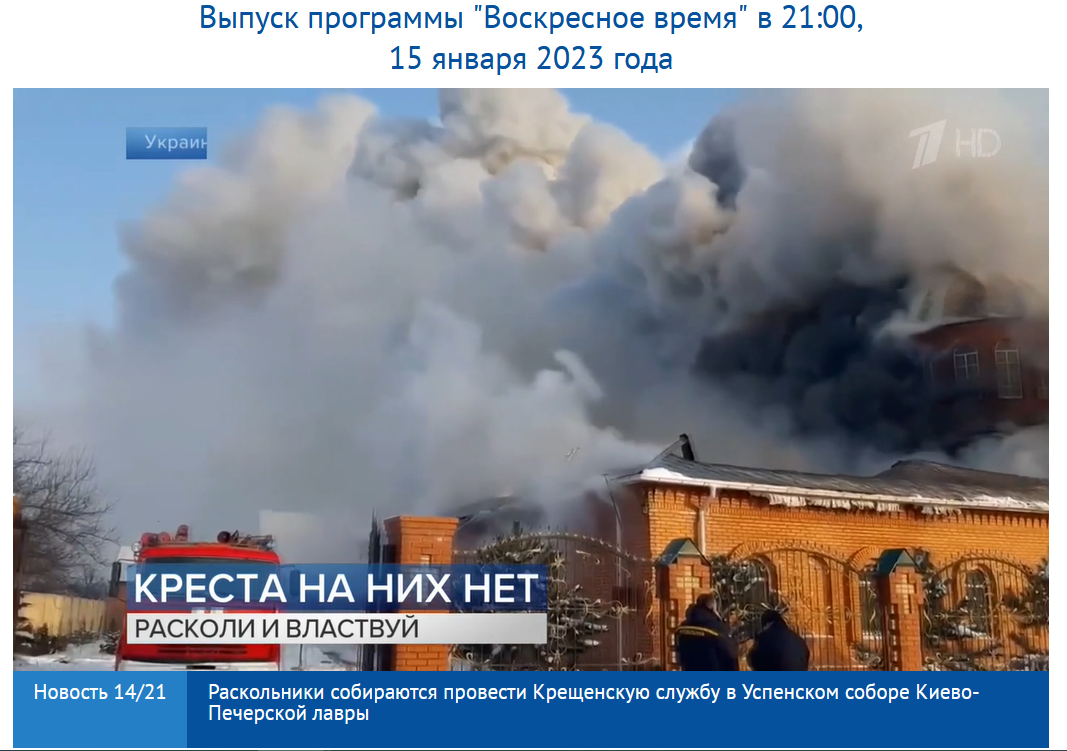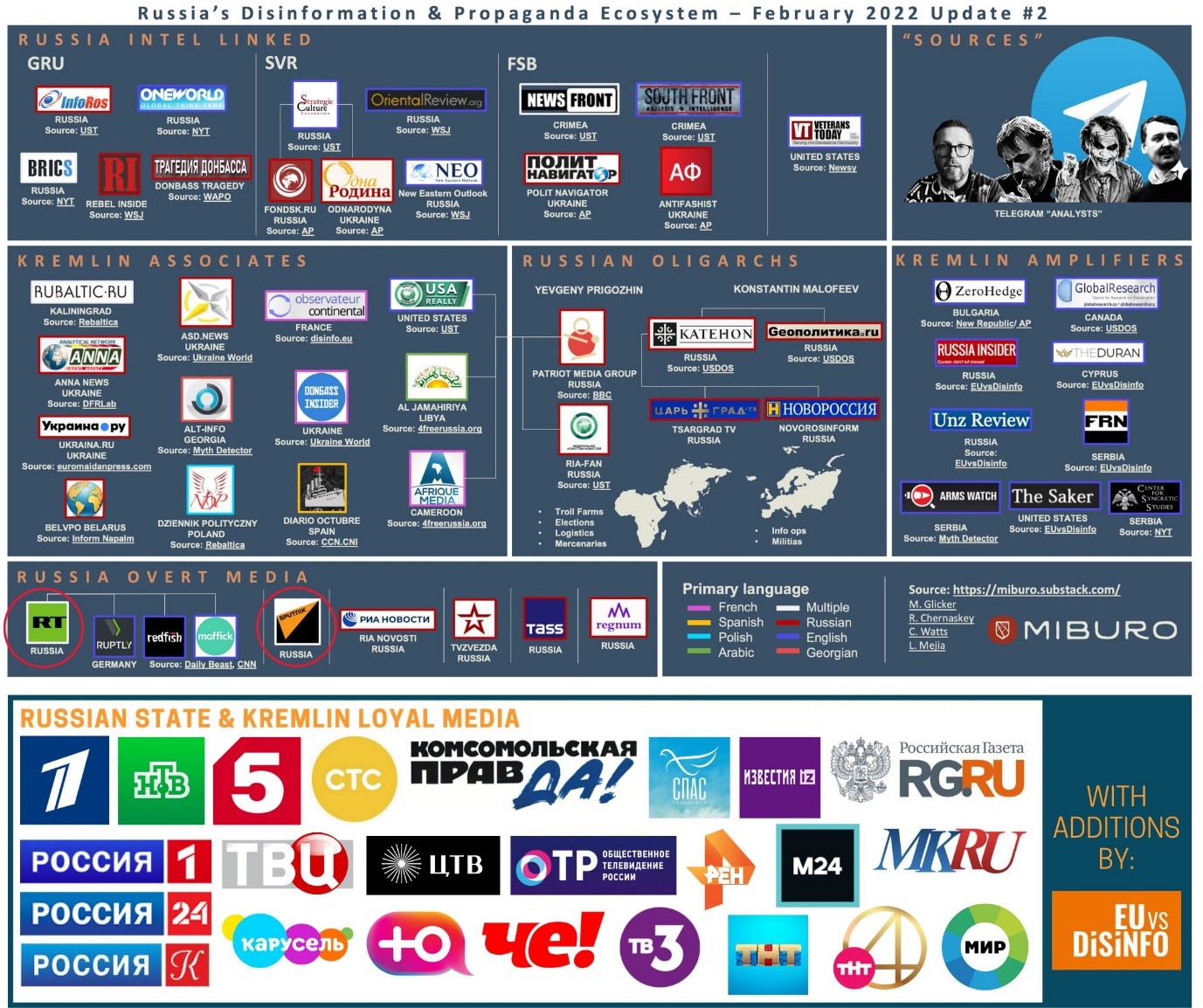Church on fire! A false news story shows how lies and manipulation are made in the Kremlin ecosystem and spread with dramatic effect. We investigate the story.
Try to imagine your feelings if you saw your church on fire in the evening TV news. Then imagine your reaction if told that a despicable neighbour had carried out the arson attack upon the mayor’s instructions.
Source — EUvsDiSiNFO — February 8, 2023 —
Table of Contents

This small but provocative question captures the desired effect most propagandists try to ignite. Emotions are the best mobilisers, not the economy, not cool rationality, not strict orders. But to turn people on, play with love, hate, passion, shame, or feelings of revenge. These are the first pages in the playbook of manipulators. It’s trivial, but it works.
Hit the high mark
At EUvsDisinfo we cast light on trends in pro-Kremlin disinformation and manipulation. With some 15,000 examples in our database plus more than 1,200 analytical articles and reports since 2015, the terrain is well mapped. But sometimes a high mark is hit when a lie is particularly incendiary.
Crucifixion – not
One world-famous example was a made-up story about a young boy’s crucifixion in a Donbas village on 12 July 2014. The main Russian state TV channel, Channel One, aired the story. The outlet also claimed that a separatist fighter’s wife was afterwards tied to the back of a tank and dragged to her death. The alleged perpetuators were Ukrainian forces and the victims Russian speakers.
The story had dramatic footage with a crying woman pretending to be a refugee eyewitness from the village. It was broadcast in the summer after the first clashes had occurred in what would soon become the war in Donbas that has lasted since 2014. The story did the job, setting Russian emotions on fire.
It was, however, an utter lie. The ‘eyewitness’ turned out to be a Russian actress who was traced back to Moscow, and not a local refugee. There was no boy. No crucifixion. No wife. No Ukrainian tank. Nothing. Just pure theatre and a creative, if shameless manipulating, Channel One journalist helping this manipulation into inventing a story. But by the time fact checkers exposed this fabrication, millions of Russians had already seen it on Channel One or relayed it on other platforms.
More fuel to the fire of emotional outrage
Since 2014, pro-Kremlin outlets have spewed many similar stories. They have suggested, for example, that Ukrainian Nazis have ganged up with the bloodthirsty West to commit atrocities in Ukraine. See here. They have also alleged that during the COVID-19 pandemic, the West was poisoning large parts of the world with dangerous Western vaccines. See here.
And that’s just the start. After Russia began a full-scale war in February 2022, a river of disinformation became a flood. Examples have included endless claims of Ukrainian war crimes against Donbas residents whom the Kremlin considers fellow Russians as well as allegations that Kyiv is acquiring nuclear or ‘dirty’ bombs, preparing chemical attacks, planning terrorist attacks on Russia, and so on. See here. Every day, outlets spread more lies, pouring fuel on the emotional fire.
Church on fire – the anatomy of the lie
Recently, we reported on another example of an emotionally charged but false story spread by Channel One. This story claimed that a Russian Orthodox church was set on fire in the Volyn region of north-western Ukraine. On 15 January, the outlet presented the story as prime time news with dramatic editing. The intent was to make the viewer believe that Ukrainian nationalists burned down a Russian Orthodox church attached to the Moscow Patriarchate. Commentators levelled harsh accusations against Kyiv authorities, all in a tone and style similar to the crucifixion story that depicted Ukrainians as inhuman or Satanic.

Again, the story was a lie, plain and simple.
Local authorities in Ukraine’s Volyn region commented that no fire was reported in any church in the area (see here(opens in a new tab) or here). In fact, Channel One have used selected parts of footage taken from a video uploaded to YouTube by Ukraine’s State Emergency Service in January 2021, one year before the invasion.
The video records an accidental fire in the Dnipropetrovsk region. The full version also shows firefighters rescuing icons and other items inside the church. Obviously, Russian TV omitted these images as they show Ukrainians taking care to preserve religious artefacts.
Tricks to manipulate
We see the same manipulation techniques in the church fire story and the crucifixion story. Outlets show a lot of footage, supposedly filmed on location. The crucifixion story shows many people in the refugee camp and it presents much circumstantial ‘evidence’ to build a plausible and trustworthy setting. The church fire story contains dynamic pictures with action and speaker engagement.
Follow the trail – how the lie spread
In the pro-Kremlin ecosystem, disinformation is usually initiated either at the top following instructions from the Kremlin administration, or from a Russian ministry, or from Russian special services running influence operations. Sometimes, however, grassroots activists and outer smaller outlets can create and spread disinformation.
The church fire story is an example of a piece created in the smaller outer tentacles that then travelled up to the centre where it was disseminated further. To use another analogy, the structure functioned like a tree where water is drawn up from the roots, through the trunk and released from the crown into the air. The process usually takes a couple of days. In this case, it took four.
Belarus state outlets usually copy or relay key elements of Kremlin narratives. They did the same here. The state wire-service and TV platforms in Minsk echoed the story.
The story’s journey also included social media platforms, websites, and TV. Its versions blended text, video, and audio.
11 January 2023, the start: a message, including a video allegedly showing the church on fire in the Volyn region, was posted on the relatively small @readovaknews Telegram channel. The message alleged that Ukrainians set the church on fire following the abbot’s refusal to transfer the church from the Moscow Patriarchate to the Kyiv Patriarchate. It quickly spread, with over 700,000 views.
11-12 January: the same video was posted by at least 10 other Telegram channels, including @RtrDonetsk (here), @swodki (here), and the larger @tsargradtv (here). The larger Russian outlet Ukraina.ru’s Telegram channel @ukraina_ru (here) reposted the video while adding a now-deleted message. The text then included the phrase ‘nationalists set on fire’ on @radiomirby (here). The video’s spread accelerated, gathering an additional 900,000 views and tallying no less than 1.6 million at that point.
The journey continued on an even larger Telegram channel, @novorossinfo (here), picked it up. Belta, the Belarusian state wire service, picked up the Ukraina.ru-version and spread it through @belta_telegramm (here). An article quoting Readovka’s Telegram message was also posted on the significant platform regnum.ru (here).
The same day, another article quoting Belta’s message was posted by the Belarusian state TV site ont.by (here). The audience in Belarus is conservatively estimated to be half a million viewers, based on media patterns including Belta’s central role in feeding other highly controlled Belarusian outlets. For an example, see here. The spread had now reached at least two million viewers.
15 January, nearing the end: Channel One aired the story on its Sunday prime time news (here). The footage aired was identical to that originally shown by @readovaknews. It did not include Readovka’s logo or banner. This footage was likely taken from Tsargrad’s @tsargradtv Telegram channel, which shared a plain, unbranded version of the video on 12 January. The link to the Channel One news stream was shared on the outlet’s Facebook page.
22 January: the Russian Armed Forces’ TV platform Zvezda published an article that included edited video and footage from @readovka’s Telegram post (here).

Impact – 100 million people
Channel One’s Sunday prime time news show has a very large audience. Viewer dynamics have changed due to the war and censorship laws as well as the closure of many independent media outlets. But even if state TV consumption has dropped to around 64% of the total Russian audience, the Sunday prime time show still has the largest share.
Channel One is known as ‘His Masters Voice’. It is carefully managed by the Kremlin and serves as a political compass of what to say, giving it a unique position as inspiration for the entire pro-Kremlin ecosystem. Its messages echo across platforms in world languages. It is quoted by media abroad and it is the reference point for what many Russians talk about. TV Zvezda is another reference point for the Russian armed forces.
Pro-Kremlin platforms often manipulate using religious themes (see here). Messages that ‘Kyiv is destroying the Russian Orthodox Church’ have appeal beyond Russian Orthodox believers. It is no coincidence that the Spanish and Arabic versions of RT and Sputnik reach large audiences in Latin America and the Arab world, respectively. RT en Español is the third-most shared site on Twitter for Spanish-language information on the war in Ukraine, outperforming local news as well as international media like the BBC or CNN, according to research published on NBC.
To sum up, the story has a collective reach of up to 100 million people across the Russian-speaking world and beyond. For such an emotional bombshell as the church fire story, such an enormous audience is dry tinder for spreading disinformation.
Prepare them mentally
Even if debunked, disinformation leaves a trace like when mud is thrown at a wall. Some falls off but some stay and a mark is left. In the words of Yale communications researcher pioneer Carl Hovland who in 1949 demonstrated how propaganda grows with the repetition of lies and that a residual message remain even when the low-trusted propaganda platform has been forgotten. This persuasion distortion was labelled “the sleeper effect”. See also here.
Beyond the numbers, continuous hate-speech and the dehumanisation of one’s adversaries as ‘Nazies in Kyiv’ have tended to compound disinformation’s effects. Specifically, such narratives make committing atrocities and genocide easier, as we have analysed here.
The Russian independent Levada Centre’s sociological research has found in periodic surveys that only 5-7 % of Russians feel ashamed by their country’s actions in Ukraine. This astonishingly low figure remained unchanged throughout 2022.
Ironically, the same TV presenter conveyed the lies regarding the church fire story in 2022 and the crucifixion story in 2014.

Overview of main actors in the Russian state & pro-Kremlin ecosystem:











